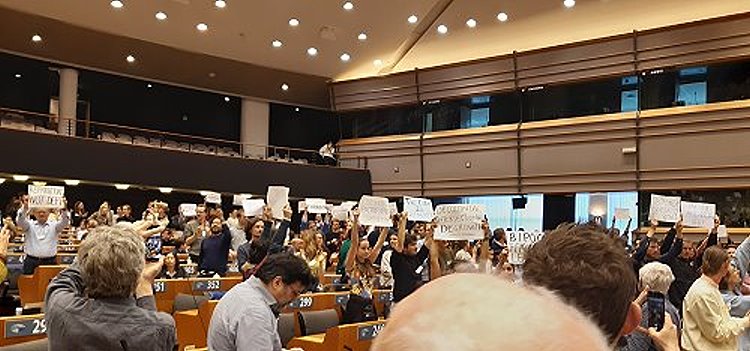 Excitement in and around the European Parliament. Droves of primarily young people standing in line to get their entry passes. They were among the 2000+ people registered for the 'Beyond Growth' Conference in the European Parliament, convened in hybrid mode. Only about half could participate in person. How can we all live dignified lives within planetary boundaries, the one planet we must share with organisms on the land, in the ocean and with fellow citizens everywhere?
Excitement in and around the European Parliament. Droves of primarily young people standing in line to get their entry passes. They were among the 2000+ people registered for the 'Beyond Growth' Conference in the European Parliament, convened in hybrid mode. Only about half could participate in person. How can we all live dignified lives within planetary boundaries, the one planet we must share with organisms on the land, in the ocean and with fellow citizens everywhere?
The central concern of the conference clearly captured the imagination of the fantastic line-up of scheduled speakers from politics, research, think tanks, advocacy groups, trade unions – and the participants flocking in as of 7h on a Monday morning to get a place. Key organiser Philippe Lamberts heading the Greens in the EP welcomed speakers and participants.

European Commission President Ursula von der Leyen speaking at the opening plenary about the Green Deal and what else needed to be done to practice economic strategies beyond impossible growth
Contrary to the first such conference five years ago, this time, not only were more political families involved in the organisation, but also the European Commission's top representatives, including President Ursula von der Leyen. The atmosphere was electric, especially when celebrity speakers combined key facts demonstrating the need to restructure the economies with advice pointing to what could be done, particularly at policy and institutional levels.
A central point was to change the goal from 'eternal' GDP growth to social prosperity. GDP is measuring all economic activities irrespective of whether they were good or harmful for people and planet and says nothing about human welfare and the state of health of our planet. It's time to rethink of what matters was a key concern. Surely, we need to question why longivity in rich countries stops or shrinks. Conversely, people in some Greek islands with very limited infrastructure and consumerism anemities, such as in Ikaria, seem 'to forget to die'? Researcher Giorgos Kallis suggested an answer that might not work everywhere, but certainly worked in Ikaria: lots of waking, talking and festivities. Not that people on the island did not have to work hard for their living, but their low impact life styles ensured a good life, prosperity with little in a locally functioning system, not destroyed in the name of modernity. Recognise it when you look around with open eyes and mind.
 Dr. Yamina Saheb of Sciences Po in Paris and Lead Author of IPCC AR6 argued for the use of the sufficiency principle to ground the development of new economic objectives focused on wellbeing. How to define this? "Sufficiency policies are a set of measures and daily practices that avoid excessive demand for energy, materials, land and water, while delivering human wellbeing for all within planetary boundaries."
Dr. Yamina Saheb of Sciences Po in Paris and Lead Author of IPCC AR6 argued for the use of the sufficiency principle to ground the development of new economic objectives focused on wellbeing. How to define this? "Sufficiency policies are a set of measures and daily practices that avoid excessive demand for energy, materials, land and water, while delivering human wellbeing for all within planetary boundaries."
She questioned that green growth as promoted by Commission policies would pass the test and expressed concern about worsening living conditions for many people even in Europe. To illustrate the point she noted that while her mother, now in her early 70s, could wheather the heat waves in Paris thanks to the air conditioning she could afford. However, she herself had suffered from one in 2021 when she gave birth in a hospital without air conditioning. She was particularly concerned about the risk that her son might have to worry in a few years about getting enough food and water when the temperatures kept kreeping up beyond human adaptive capacity, that is reaching 2°C. Will we then see fierce fights over access to basics because the Earth system has spun completely out of control?
She got standing ovations with translating the science into language and scenarios more readily understood than some of the numbers and graphs plugged directly from scientific publications.
Timothée Parrique from the University of Lund, Sweden, illustrated five types of decoupling economic activities from increases for energy and materials. He suggested that for achieving 55% reduction of CO2 emissions by 2030 GDP needed to decrease by 1 to 2% per year. That looks quite feasible for taking the economy out of ecological overshoot and decoupling wellbeing from overconsumption. His key advice was to seek greater simplicity echoing Yamina Saheb. A focus on sufficiency could reorient ambitions towards meeting basic needs and fairness.

Graph shown by Timothée Parrique from Lund University about a feasible corridor of degrowth to stablise the planet for safe conditions for humans and ecosystems
Reducing resource use was also urgent to address security risks provoked by excessive dependency for critical minerals from few countries according to Olivia Lazard from Carnegie Europe. She warned that the explosive growth of the IT industries did not help to decarbonise the economy. It was, on the contrary, requiring more and more resources. She cautioned about multiple risks and advocated preventing another scamble for Africa, this time in the name of 'green growth' or a 'green economy'.
Understanding the biophysical limits to growth is essential for building an economy that respects planetary boundaries. Johan Rockström, Director of the Potsdam Climate Impact Research Institute, was unequivocal. The four overlapping crises – the climate crisis, the ecological crisis, the covid-19 pandemic and the war in Ukraine – were already provoking high social and economic costs engendered by exceeding 6 out of 9 boundaries. In his sober manner, he reminded the audience that between 1971 and 2018, the rise in Ocean Heat Content accounts for over 90% of Earth's excess thermal energy from global heating. That brings us close to hard wired tipping points which will shift the Earth System into an entirely different gear. We are close or perhaps even beyond four of them, for example as far as the West Antarctic ice sheet and Greenland glaciers are concerned. By all means did he want to encourage decisive counter measures.
Business as usual or a quick technofix just won't do it. We have major transformations ahead and the issue is how to shape them in ways that are good for people and planet.










